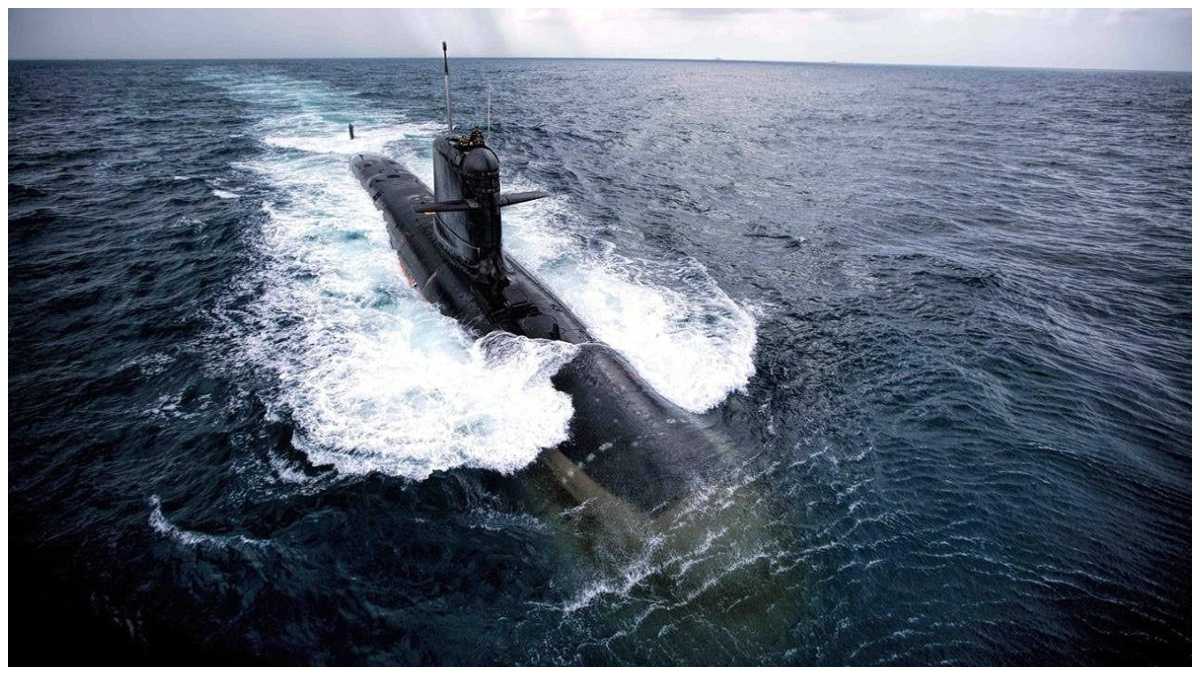Defence Minister Rajnath Singh is set to commission India’s second nuclear-powered ballistic missile submarine (SSBN), INS Arighat, in a discreet ceremony in Visakhapatnam on Thursday. This significant event, attended by Chief of Naval Staff Admiral Dinesh Tripathi, Vice Admiral Suraj Berry of India’s Strategic Forces Command, and senior Defence Research and Development Organisation (DRDO) officials, marks a crucial advancement in strengthening India’s maritime defence capabilities. INS Arighat, also known as S-3, is poised to enhance India’s underwater nuclear deterrent, equipped with K-15 nuclear ballistic missiles that have a range of 750 kilometers, making it ready for long-range patrols in the Indo-Pacific.
INS Arighat boosts India’s naval power
The Defence Ministry has maintained a tight lid on the classified project, but sources have confirmed that the 6,000-tonne INS Arighat is now fully operational. This marks a pivotal step in India’s nuclear triad and second-strike capability, particularly given the nation’s commitment to a no-first-use nuclear policy. With the induction of INS Arighat, India now has two nuclear-powered submarines INS Arihant (S-2) and INS Arighat actively patrolling the oceans, ensuring a credible second-strike deterrent against potential adversaries.
Features of INS Arighat
INS Arighat, India’s latest nuclear-powered ballistic missile submarine, is designed with formidable capabilities. Like its predecessor, INS Arihant, Arighat can carry up to four K-4 submarine-launched ballistic Missiles (SLBMs), each with a range exceeding 3,500 kilometers, or twelve K-15 SLBMs, which have a range of around 750 kilometers. The K-15 missiles can be equipped with strategic nuclear warheads, enhancing the submarine’s deterrent capabilities. In addition to its missile systems, INS Arighat is also armed with advanced torpedoes, making it a versatile and potent asset in India’s naval arsenal.
Next SSBN ready for launch
In addition to the commissioning of INS Arighat, India’s third SSBN, INS Aridaman (S-4), is expected to be commissioned next year, followed by a fourth submarine, codenamed S-4. This expansion of India’s underwater nuclear deterrent highlights its strategic focus on enhancing its naval capabilities to counter threats in the Indo-Pacific region. The SSBNs, powered by indigenous nuclear reactors and armed with nuclear missiles developed within the country, represent a significant technological leap. While INS Arihant served as a prototype, INS Arighat addresses previous technological gaps, making it a more advanced and capable vessel.
Looking ahead, India plans to begin construction on a new class of submarines that will be significantly larger and equipped with nuclear ballistic missiles with a range of up to 3,000 kilometers. These submarines will feature additional missile tubes, further strengthening India’s strategic capabilities. This development is part of a broader initiative to enhance the Indian Navy’s prowess, particularly in the context of India’s strategic location in the Indo-Pacific.
Also Read: MURDER At Bengaluru Airport: Man Kills Trolley Operator Over Suspected Affair With Wife
Submarines in India
India maintains a diverse fleet of conventional and nuclear-powered submarines, each equipped with advanced sensors, armaments, and propulsion systems tailored for specific maritime missions.
Conventional Submarines
India operates three classes of conventional submarines:
1. Shishumar Class: Four submarines, commissioned through technology transfer from Germany, are outfitted with sophisticated sensors optimized for anti-submarine and anti-ship warfare, enhancing India’s dominance in the Arabian Sea. The commissioned submarines in this class include INS Shishumar, INS Shankush, INS Shalki, and INS Shankul.
2. Sindhughosh Class: This class consists of seven active Kilo-class submarines of Russian origin. Originally, ten were commissioned, but three have since been decommissioned. These submarines are equipped with satellite sensors, radar, sonar, electronic surveillance systems, and anti-ship and anti-submarine weaponry. The currently active submarines are INS Sindhughosh, INS Sindhudhvaj, INS Sindhuraj, INS Sindhuvir, INS Sindhuratna, and INS Sindhukesari.
3. Kalvari Class: Six diesel-electric submarines, built indigenously under Project 75 with designs based on France’s Scorpene-class submarines, are in service. The commissioned submarines are INS Kalvari, INS Khanderi, INS Karanj, INS Vela, and INS Vagir, with INS Vagsheer, the sixth and final submarine of Project 75, set to join the fleet in 2024. Future developments include adding Air Independent Propulsion (AIP) technology under Project 75 (I).
Nuclear-Powered Attack Submarines (SSNs):
Currently, India lacks operational SSNs following the decommissioning of the leased Akula-class INS Chakra II in 2021. The Indian Navy has ordered another Akula-class submarine, INS Chakra III, scheduled for induction in 2025, and is also planning for indigenous Project 75 Alpha SSNs in the future.
Nuclear Ballistic Missile Submarines (SSBNs):
India’s SSBN fleet includes the INS Arihant, an indigenously developed vessel under the Advanced Technology Vessel program. Launched in 2009 and commissioned in 2016, INS Arihant features a double-hull structure and is equipped with advanced sensors, periscopes, and weapon systems. It can carry either 12 K-15 (Sagarika) missiles with a 750 km range or 4 K-4 missiles with a 3500 km range. INS Arighat, India’s second SSBN, is an upgraded version of INS Arihant, with further SSBNs S4 and S5 in the planning stages.
Indian Navy seeks SSN Submarine approval
The Indian Navy is seeking approval from the Narendra Modi government to construct two nuclear-powered conventionally armed submarines (SSNs). Unlike diesel-electric attack submarines (SSKs), which need to surface frequently to recharge their batteries, SSBNs can remain submerged for extended periods, limited only by logistical needs such as supplies and crew rotations. This ability enhances India’s strategic reach and operational flexibility.
In the coming months, the Indian Navy’s capabilities will expand further with the commissioning of several advanced warships. These include the latest guided missile stealth destroyer, INS Surat, the stealth-guided missile frigate, INS Taragiri, and the sixth Kalveri-class attack submarine, INS Vagsheer. Additionally, orders for three more Kalveri-class submarines are expected to be placed with Mazagon Dock Shipbuilders Ltd in Mumbai later this year. These developments underscore India’s commitment to bolstering its naval defense capabilities in an increasingly complex and challenging maritime environment.













